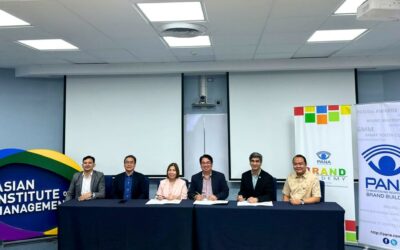PANA General Assembly Discusses New Ways to Reach Your Markets
The latest gathering of advertising industry experts featured interesting talks about how to engage customers in new and exciting ways. According to PANA Treasurer Tricia Quiambao, The theme for the General Membership Meeting for the first quarter of this year focuses on elevating the practice of advertising and marketing especially with the new challenges in the industry. The key is creating relevant content, she says, and how it can benefit you and the company.
One of the guest speakers at the meeting was Jacob Maimon, CEO of Star 8 Green Technology Corporation, who presented a viable solution for the transportation problem being faced in Metro Manila and the other major cities in the country. There is currently a clamor for the phase-out of the iconic King of the Road, where the older units will be deemed as not roadworthy and should stop plying the streets. The jeepneys are also said to be fuel-inefficient and contributors to the worsening air conditions in the congested Metros. The problem is that there is yet to be a replacement for this type of transportation that is heavily relied upon by Filipinos to get to their daily destinations.
What Maimon proposes is to substitute the old vehicles with his more efficient models that run on solar power. When the question of economics came up, he presented an idea that piqued the audience’s interest.
The Australian inventor shared that he is planning to give out the solar-powered vehicles to operators for free, in exchange for advertising rights. As he explains it, the passengers are a captive audience who can watch ads being streamed into the monitors placed strategically inside the jeepneys. The audience can watch the ads while in transit, unlike traditional media such as billboards and cannot be skipped unlike online ads on Youtube. This, he says, will help advertisers reach a wider market within their target audience.
The next speakers at the forum were Abby Chan of Acorn Marketing Research Consultants and Manfred Tautscher of the SINUS Institute. They unveiled the finding of their research about Listening to the Asian Mind, which looks at the market wholistically while also breaking it down into segments by country, by generation, and by aspiration. In their explanation, the traditional way of looking at the ad audience is to simply group them by age. However, their study has shown that one Gen Y member may not necessarily look for the same things as someone in that same age group. They use the word milieu instead of generational labels to group the consumers according to preferences.
They advised that advertisers and marketers have to look deeper into demographics, with the end result of creating targeted ads that will fit into their market’s needs. This means looking into the lifestyles and attitudes that are detailed in their published study that also looks into worldwide trends.
Star 8 not only offered free rides for the participants on the Makati route using their solar-powered vehicles, they also gave away the major prizes at the event’s raffle, generously increasing the number from three scooters to six, to the delight of the attendees.
A Peek at the Filipino Psyche
When Abby Tan of Acorn Marketing Research Consultants took to the stage at the first quarter General Membership Meeting of the PANA in Makati, she gave out significant insights about the Pinoy, based on their detailed report about Listening to the Asian Mind.
“This is the first-ever study that covers Asian markets, using full-scale segmentation based on the Sinus model, which is our partner in the study. It looks into many aspects of consumer life and the impact of digital on lifestyle on aspects that include health and wellness, telcos, fashion, and luxury items,” she explains.
She also advises the marketers and advertisers to understand that people are now very multifaceted. “If you want to engage consumers effectively, don’t look at them in one category. You have to also look wholistically, especially at this time when things are very borderless.”
Here are snippets of their findings that she shared with her audience:
Filipinos are optimistic. Fifty-two percent of our Asian neighbours have appositive outlook, and the Philippines ranks third among those with the highest levels of happiness. The common denominators with our happy neighbours include string family ties versus individualism and less hectic workplaces, allowing for a work/life balance. Developed countries such as Hong Kong, Singapore, Japan, and Korea are unhappy because they feel that they are working harder for less.
Good looks count. The silver-haired and Gen X are the most jaded and less optimistic of the future, because of their been-there-done-that mentality, where they have gone thorough People Power and several changes of administration without feeling any effective change. The younger generations say they are optimistic and happy because they feel they have good relationships with family and friends, get social recognition, and have good looks. Millennials who are now “adulting” are less satisfied, because they worry about job security, financial capability, and the thought of aging.
Pinoys are socially and politically aware. Throughout the region, social issues are shared. Things that concern Filipinos such as human rights affordable healthcare, and government corruption also affect citizens of other countries. On top of these, Filipinos are also bothered by issues like the fight against criminality, economic growth, public education, and climate change.
The Pope is an icon. Across the region, celebrities are being replaced as role models. Parents are on top of the list, as are tech gurus Mark Zuckerbuerg of Facebook, Bill Gates of Microsoft, and Steve Jobs of Apple. Since the country is predominantly catholic, Pope Francis is also considered as a role model of choice. Other aspirational figures include politicians (Pres. Duterte) and business tycoons (SM’s Henry Sy) and rags-to-riches stories (boxer-turned –Senator Manny Pacquiao).
Almost everyone is online. Uber and Grab are top transportation apps in the region. Connections are made on social media apps, with a 100% penetration of Facebook in the country, with Viber edging out Whatsapp as the messaging tool of choice for Pinoys. Other popular online apps are Youtube, Google, and Instagram. Shopping is another to online activity, with Pinoys purchasing gadgets, fashion, and accessories from online sellers, albeit preferring the Cash on Delivery or Paypal modes of payment instead of the credit cards that are more often used in other countries.
The more detailed research study consists of 500 pages, Tan says. This is only the tip of the idceberg that is further broken down to milieus, as detailed by their project partner Sinus.



